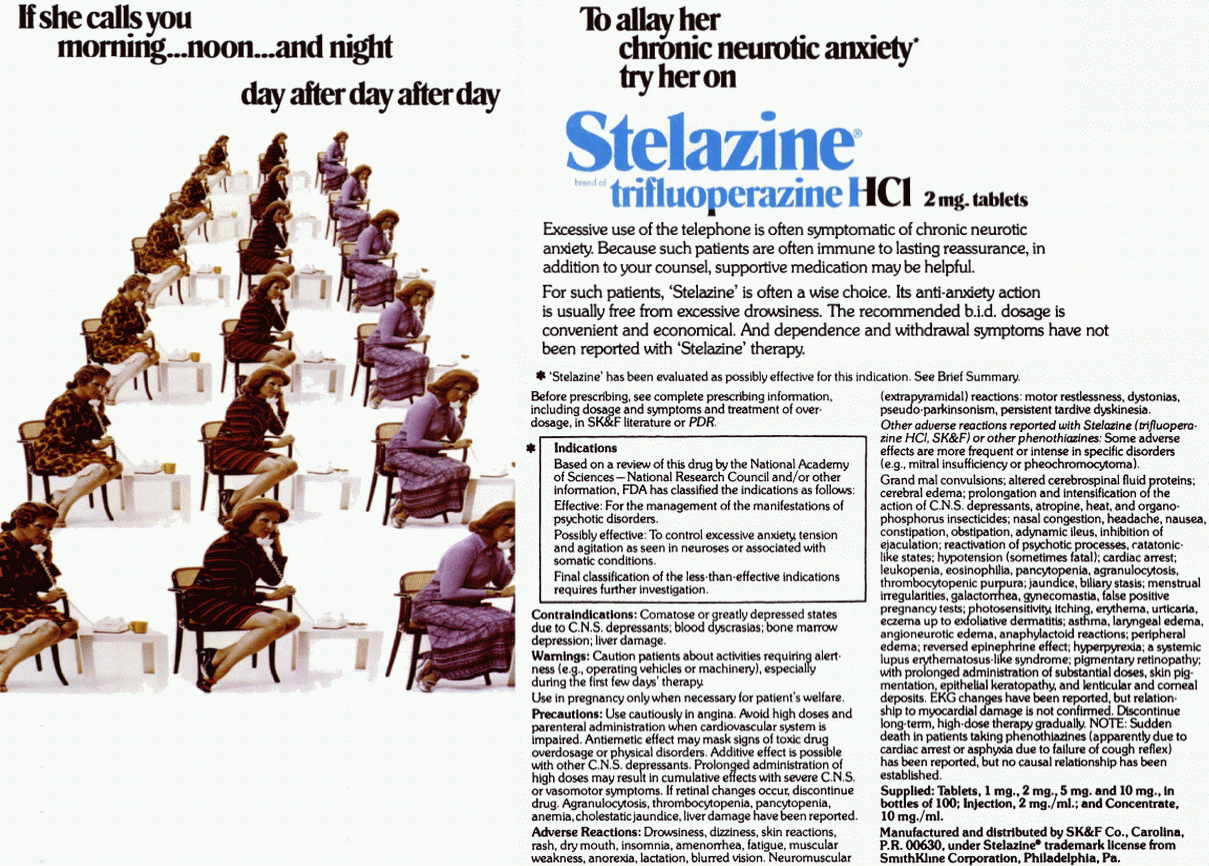

|
|
Stelazine advertisement, 1973. Hospital & Community Psychiatry, Vol. 24, No. 7. If she calls you morning... noon... and night day after day after day To allay her chronic neurotic anxiety try her on STELAZINE® brand of trifluoperazine HCL 2 mg. tablets Excessive use of the telephone is often symptomatic of chronic neurotic anxiety. Because such patients are often immune to lasting reassurance, in addition to your counsel, supportive medication may be helpful. For such patients, 'Stelazine' is often a wise choice. Its anti-anxiety action is usually free from excessive drowsiness. The recommended b.i.d. dosage is convenient and economical. And dependence and withdrawal symptoms have not been reported with 'Stelazine' therapy. * 'Stelazine' has been evaluated as possibly effective for this indication. See Brief Summary. Indications: Based on a review of this drug by the National Academy of Sciences - National Research Council and/or other information, FDA has classified the indications as follows: Effective: For the management of the manifestations of psychotic disorders. Possibly effective: To control excessive anxiety, tension and agitation as seen in neuroses or associated with somatic conditions. Final classification of the less-than-effective indications requires further investigation. Adverse Reactions: Drowsiness, dizziness, skin reactions, rash, dry mouth, insomnia, amenorrhea, fatigue, muscular weakness, anorexia, lactation, blurred vision. Neuromuscular (extrapyramidal) reactions: motor restlessness, dystonia, pseudo-parkinsonism, persistent tardive dyskinesia. Other adverse reactions reported with Stelazine (trifluoperazine HCl, SK&F) or other phenothiazines: Some adverse effects are more frequent or intense in specific disorders (e.g., mitral insufficiency or pheochromocytoma). Grand mal convulsions; altered cerebrospinal fluid proteins; cerebral edema; prolongation and intensification of the action of C.N.S. depressants, atropine, heat, and organophosphorus insecticides; nasal congestion, headache, nausea, constipation, obstipation, adynamic ileus, inhibition of ejaculation; reactivation of psychotic processes, catatonic-like states; hypotension (sometimes fatal); cardiac arrest; leukopenia, eosinophilia, pancytopenia, agranulocytosis, thrombocytopenic purpura; jaundice, billary stasis; menstrual irregularities, galactorrhea, gyneomastia, false positive pregnancy tests; photosensitivity, itching, erythema, urticaria, eczema up to exfoliative dermatitis; asthma, laryngeal edema, angioneurotic edema, anaphylactoid reactions; peripheral edema; reversed epinephrine effect; hyperpyrexia; a systemic lupus erythematosus-like syndrome; pigmentary retinopathy; with longed administration of substantial doses, skin pigmentation, epithelia keratopathy, and lenticular and corneal deposits. EKG changes have been reported, but relationship to myocardial damage is not confirmed. Discontinue long-term, high-dose therapy gradually. NOTE: Sudden death in patients taking phenothiazines (apparently due to cardiac arrest or asphyxia due to failure of cough reflex) has been reported, but no causal relationship has been established. Supplied: Tablets, 1 mg., 2 mg., 5 mg. and 10 mg., in bottles of 100; Injection, 2 mg./ml.; and Concentrate, 10 mg./ml. Manufactured and distributed by SK&F Co., Carolina, P.R. 00630, under Stelazine® trademark license from SmithKline Corporation, Philadelphia, Pa. |